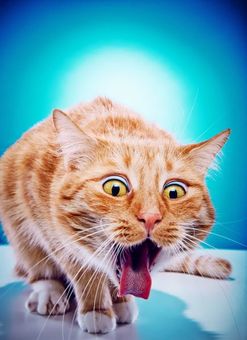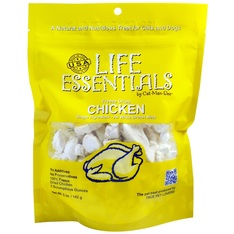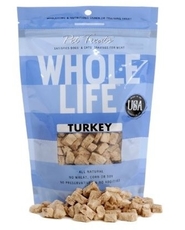When a cat has a frothy vomit or throws up bile, it is almost always because there was acid or bile build-up in an empty stomach. And if kitty has stomach acid and/or bile sitting in the stomach in anticipation of a meal, that meal will most likely be regurgitated. This usually happens with breakfast, being the longest period between meals, but it can happen at any meal (especially if we're late with a meal, or if we only feed two meals a day). When feeding homemade food, this is rarely the result of eating too quickly, which is often suggested as the cause. What you're witnessing is a kitty transitioning to a protein-based, species appropriate diet, and their bodies are returning to their more natural, more acidic state. It is not cause for alarm, and it is easily managed.
A whitish foam is stomach acid. Yellow liquid is bile.
Of course, if your cat is vomiting repeatedly, projectile vomiting, not keeping anything down (not even water), or you suspect the cat ate or drank a poisonous substance or swallowed something inedible, please take kitty to the vet. And if throwing up acid or meals frequently continues despite these recommended steps, see the vet. This can be a sign of a blockage that needs surgical attention - or, if your cat has not had blood work done recently, please get this done. This can also be a symptom of many illnesses, including pancreatitis, chronic kidney disease or hyperthyroidism, each of which needs management or treatment.
But a cat vomiting stomach acid, bile, or immediately throwing up a meal, is quite common in cats new to set meal times or raw/homemade food. As explained by Lyn Thomson, BVSc DipHom writing for the Feline Nutrition Foundation in Gastric Acidity - What, How and Why
"Cats need a highly acidic stomach in order to properly digest their food. But, the carbohydrates in many processed foods make the stomach less acidic. Meat protein stimulates stomach acidity by triggering the production of hydrochloric acid in acid-secreting cells within the stomach. A complex cascade takes place when a cat or dog ingests food. Put simply, 80% of the gastric juices secreted are a direct result of chemoreceptors in the stomach detecting the presence of meat-based proteins. This keeps the stomach at a very low pH of around 1-2. A low pH means high acidity. This low stomach pH is important because digestive enzymes work best in an acidic environment and the acidity in the stomach will sterilize ingested pathogens, bacterial or fungal.
When a cat or dog swallows a commercial pet food that is high in carbohydrate and plant protein and low in meat protein, acid-secreting cells in the stomach are not stimulated to produce much hydrochloric acid. The pH within the stomach rises to around 4-5 and a high pH means low acidity. The acidic chyme leaving the stomach is the trigger for the next stage of digestion in the small intestine. The acidity encourages the flow of bile and the flow of pancreatic enzymes necessary to continue the digestive process. If the stomach contents are not sitting at a pH of around 1-2, then digestion is impaired throughout the rest of the digestive tract as well."
Cats normally, naturally, have very acidic systems. Their stomachs secrete powerful digestive enzymes with about 10 times the amount of hydrochloric acid than that of a human. As Dr. Thomson pointed out, the pH of a carnivore’s stomach is around 1-2 (highly acidic) - but they are able to maintain that highly acidic environment even with (high protein) food in the stomach. For humans, the pH ranges from 4 – 5 with food in the stomach. Thus it is that when we start feeding our cats a diet that is similar to what they naturally eat, their bodies can take some time to adjust. And we can help them.
How Do I Fix Stomach Acid/Bile Pukes?
Needing to take steps to help our kitties adjust to the changes is very common, and it DOES resolve!
- Increase the number of meals you feed your cat. Cats, as we know, are obligate carnivores that primarily hunt small animals. According to the Nutrient Requirements of Dogs and Cats, (p 22) feral cats need to hunt and eat about eight to 12 prey per day to meet their energy requirements. Obviously our indoor cats don’t need the same number of calories to maintain their weight, but the bottom line is that cats aren’t designed to eat just one or two meals a day. Unless you work from home, it can be difficult to accommodate many small meals, but this isn’t necessary. Most cats do just fine with three meals a day, fed before work, after work, and before bed. The meals do not need to be spaced evenly. There’s no need to adjust the quantity of each meal just because they aren’t fed at even intervals: take the daily amount of food your cat should eat and divide it evenly into the number of meals you want to feed (or that you determine kitty needs). Note: This said, there can be a benefit to feeding two meals a day to the cat. Many of our kitties already have some impairment of motility when we transition to raw/homemade food. Acid management will almost certainly need to be employed if transitioning an older adult cat that is eating two meals a day. The older your kitty at the time of transition, typically the longer this adjustment takes. But one advantage of two meals a day is much stronger hunger pangs. If - or when - your kitty is able to adjust to two meals a day, these really strong hunger pangs can reduce or eliminate hairballs, as "indigestible solids" are the last thing to be pushed out of the stomach. Those really strong hunger pangs do the job really well. But if you are not already feeding two meals a day and your kitty is having acid issues during the transition, please do not try to move to two meals a day until your kitty is comfortable and completely adjusted to the new diet.
- Shorten the amount of time between the last meal of the day and the first meal of the morning if morning is the only time there's an issue. If you have one cat, a timed feeder for a bit of freeze dried raw food, a few freeze dried meat treats, or one that can accommodate an ice pack for a bit of raw food) can solve the timing problem. And while we don’t want to feed breakfast to kitty the moment we get up (or they associate us waking up with being fed, so they’re motivated to wake us up!), some people’s schedules accommodate feeding the first meal earlier - or the last meal later.
- Put the stomach acid to work. If the last meal you feed isn’t just before bed, give kitty a few small bites of freeze dried meat treat before you get into bed. Also give your kitty a few bites of freeze dried meat treat about 20 minutes before their first meal of the day. Or if it isn't that first meal that's the problem, feed kitty a small bite of the food you'll feed at the meal or a small freeze dried meat treat 20 minutes before the meal that is. Or consider doing this before each meal you feed. If there’s too much acid in the stomach, he may throw up those treats – but the meal will stay down. If kitty does throw up, wait a few minutes, give another small bite of food or freeze dried meat treat to settle his stomach, and then feed breakfast after about 10 minutes or so.
- Feed a few freeze dried meat treats if you get up during the night.
- Hide a few freeze dried meat treats for your kitty to find overnight or during the day while at work.
Needing to take steps to help our kitties adjust to the changes is very common, and it DOES resolve!
When to Seek Vet Care When Your Cat is Vomiting
Please note, a symptom of pancreatitis is frequent (often intense) vomiting. Cats with chronic kidney disease (CKD) or cats with hyperthyroidism (Hyper-T) can experience acid/bile vomiting as a side-effect of the disease. When was the last time your cat had blood work? How old is your cat? Is your cat drinking more water than normal? These conditions require a different form of management. Altering meal times and putting the stomach acid / bile to work can certainly help manage the symptoms, but the underlying health must be properly addressed.
Please also seek vet care for your cat that is throwing up along with other symptoms, such as
- Lethargy
- Excessive water drinking
- Repeat vomiting / can’t keep anything down / projective vomiting
- Bloated stomach
- Breathing problems
- Fever
- Kitty has been losing weight
Summary
Adjusting meal times in combination with putting the stomach acid/bile to work is usually all it takes to resolve overnight (or between-meal) acid vomiting, and breakfast (or other) meal regurgitation. Add a third (or fourth) meal, make the last meal later, and if possible, the first meal earlier. And/or try giving your kitty a few freeze dried meat treats overnight if you can, and certainly 15 - 20 minutes before the first meal of the day or the problem meal. These simple steps are usually all it takes to resolve the problem!



